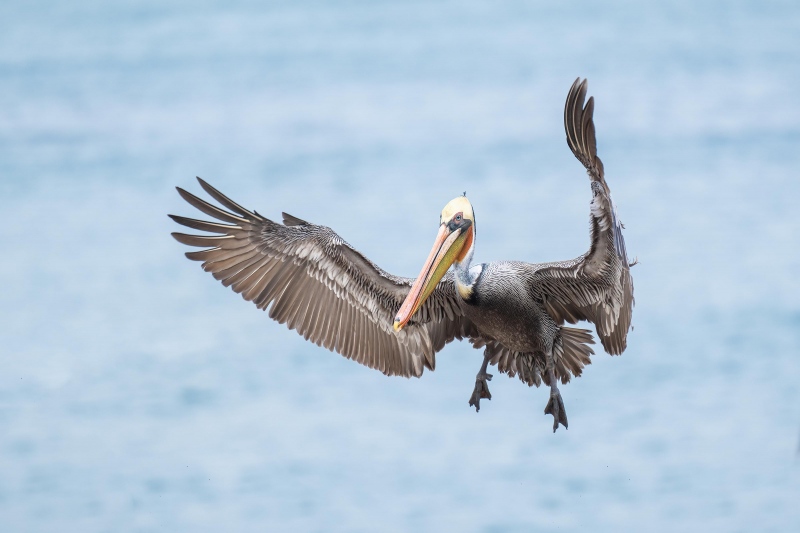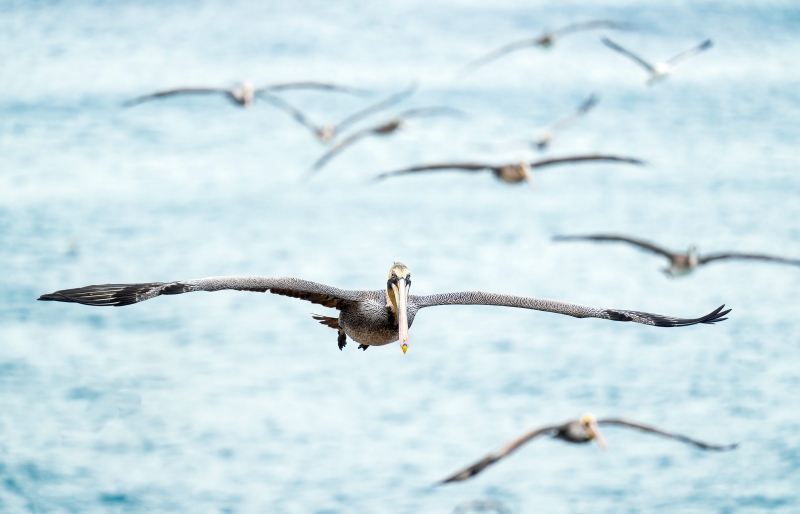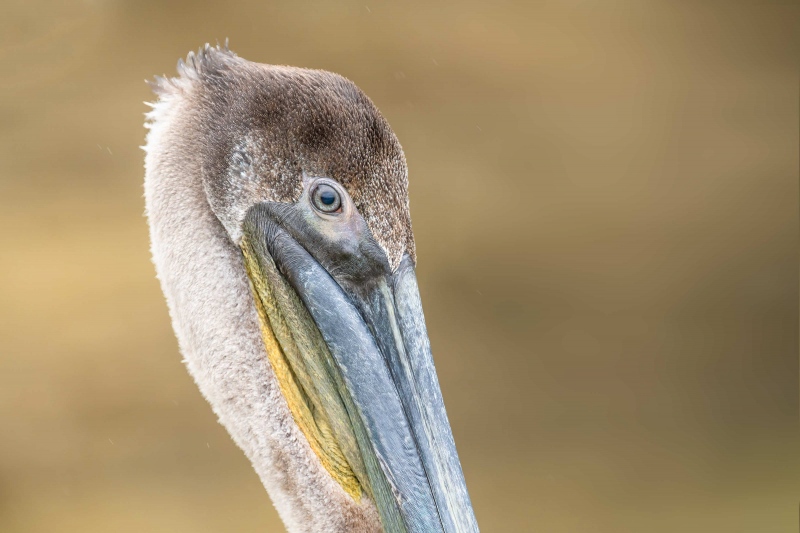My Calls
Everyone but Kevin Hice thought that I should have eliminated the seventh, extra leg in Image #1. He wrote, Being that asymmetric is always better; I would leave the seventh leg. I agree with Kevin. Most folks liked Image #1 best. I liked image #2 best as there was more meat on the bone.
As far as the How might this image been improved had I (by luck) placed my tripod one inch to my left?, question, Bob Eastman finally got to the right answer after I gave him a very strong clue. Simply put, the muddy droplets would have been better placed against an open area of water in the background and the merge of the lower droplets with the o-o-f leg would have been avoided. As I have learned on most IPTs, many photographers have trouble understanding how the spatial relationships between various elements of an image vary with either small or large changes in perspective. I’ve done countless demos at brunch using the salt and pepper shakers to further understanding.
What’s Up?
The stitches came out yesterday and all is looking good. I walked 3.5 miles each of the last two days at Avalon Park Preserve and around the harbor, both in Stony Brook.
Today is 6 June 2023. I should be finishing up the flight photograph e-Book today or tomorrow. This blog post took about 90 minutes to prepare. Wherever you are and whatever you are doing, I hope that you too are gonna have a great day.
I was happy to learn on Sunday that multiple IPT veteran/Galapagos Photo-Cruise of a Lifetime veteran Dietmar Haenchen has signed up for the 3rd San Diego IPT.
All are cordially invited to join me at Nickerson Beach this month or next year or on a Homer or a San Diego Instructional Photo Tour (IPT). I will be announcing fall dates for two or three Fort DeSoto IPTs soon. Not to mention a Galapagos Photo-Cruise of a Lifetime in August 2024.
Please remember to use the B&H and Amazon links that are found on most blog pages and to use the BIRDSASART discount code at checkout when purchasing your new gear from Bedfords to get 3% back on your credit card and enjoy free second-day air FedEx. Please, also, consider joining a BAA IPT. You will be amazed at how much you will learn!
You can find some great photo accessories (and necessities, like surf booties!) on Amazon by clicking on the Stuff tab on the orange/yellow menu bar above. On a related note, it would be extremely helpful if blog-folks who, like me, spend too much money on Amazon, would get in the habit of clicking on the Amazon logo link on the right side of each blog post when they shop online. As you might expect, doing so will not cost you a single penny, but would be appreciated tremendously by yours truly. And doing so works seamlessly with your Amazon Prime account.
Please remember that if an item — a Delkin flash card, or a tripod head — for example, that is available from B&H and/or Bedfords, is also available in the BAA Online Store, it would be great, and greatly appreciated, if you would opt to purchase from us. We will match any price. Please remember also to use my B&H affiliate links or to earn 3% cash back at Bedfords by using the BIRDSASART discount code at checkout for your major gear purchases. Doing either often earns you free guides and/or discounts. And always earns my great appreciation.
Nikon Z7 II Mirrorless Camera/with extras!
Price Reduces $200.00 on 6 June 2023!
BAA Used Gear Page veteran David Rice is offering a Nikon Mirrorless Z7 II in excellent plus condition for a very low $1546.35 (was $1746.95). The sale includes the original box and the manual, three Nikon batteries (a $138.00 extra value) with the charger, the front body cap, a 64GB XQD Lexar Memory Card, the strap, the front body cap, a RRS L-Bracket (a $210.00 value), and insured ground shipping via major courier to lower-48 US addresses only.
Please contact David via e-mail.
High-Resolution Image Making
Improved processing, greater versatility, but familiar in design, the Nikon Z7 II takes everything that was great from the original and ups its capabilities even more. Sporting a high-resolution 45.7MP FX-format BSI CMOS sensor and dual EXPEED 6 image processors, the Z7 II is clearly aimed at the detail-obsessed image-maker. Improving upon their initial efforts, Nikon has revised the Z7 platform to offer more speed, faster processing, and greater versatility without sacrificing the beloved qualities of the original camera. The sensor’s design omits the optical low-pass filter for greater detail recording capability and the sensor supports a native sensitivity range down to ISO 64 for lush, rich captures. Updated processing also yields faster speeds, including a 10 fps continuous shooting rate and a deeper buffer for working with moving subjects. Updated autofocus now includes Eye and Face Detection for both humans and animals in the Wide-Area AF mode, for both photo and video recording. Nikon and B&H
If you are a general nature photographer looking to get into Nikon mirrorless without spending $5,500.00 on a Z9, you are in the right place. I’ve seen some great flight images with the Nikon Z6 II so I have no doubt that the Z7 II can do the same even better. As this body sells new for $2,996.95, you can save a bundle by being the one to grab David’s Z7 II along with some great extras. artie
The Fact$ of Life
The market for editorial sales of natural history images has virtually disappeared. The incomes of the world’s top stock photographers are down by at least 90%. Like me, most depend on income from photo trips, the sale of educational materials, and income from this or that affiliate program.
In 2001, BAA sold the publication rights to images for nearly one-quarter million US dollars. That amount dropped to about $20,000 by 2011, and in 2017, to slightly more than $2,000.00. We’ve stopped counting. IPTs used to fill within days. Now I am happy to go with one or two folks, but I’d much rather have you along. And so it goes. In 2009, I turned to creating educational blog posts, now to the tune of 4026. Yes, 4026 educational blog posts. So, please remember to use either my B&H or Bedfords affiliate links for your major purposes. It does not cost you one cent to do either.
B&H
Many folks have written recently stating that they purchased a Sony a1 from B&H and would like their free membership in the Sony 1 Info and Updates Group, a $150.00 value. When I check my affiliate account, their orders have not been there. When I let them know that they get credit for B&H purchases only if they use one of the many B&H affiliate links on the blog or begin their searches with this link, they are always disappointed. If in doubt, please contact me via e-mail and request a BH link. I am always glad to help and to guide you to the right gear.
B&H Simplified
To ensure that I get credit for your B&H purchases, you can always click here. The tracking is invisible but greatly appreciated. And, you can use your PayBoo card. You must use the website to order. Thanking me for the past 4000 educational blog posts could not be any easier and will not cost you one penny. Please shoot me your B&H receipt for major purchases.
Bedfords Simplified
Click here to start your search. Choose standard shipping, and when you get to the payment page, enter BIRDSASART in the discount code box and hit apply. You will be upgraded to free second day air Fed-Ex and receive 3% cash back on your credit card once your stuff ships. Either is greatly appreciated by yours truly.
Iceland
My decades-long dream of spending time on Grimsey Island, Iceland, with the puffins — 13 days in this case!, will be realized this coming July. I am doing back-to-back trips as a participant. If anyone would like information on the world’s greatest Iceland/Atlantic Puffin trip this coming July, please contact me via e-mail.
|
|
|
This image was created on 1 January 2023 at La Jolla, CA while scouting for a San Diego IPT. I used the hand held Sony FE 70-200mm f/2.8 GM OSS II lens with the Sony FE 1.4x Teleconverter (at 280mm) and The One, the Sony Alpha 1 Mirrorless Digital Camera.. The exposure was determined via Zebras. ISO 1250: 1/3200 sec. at f/4 (wide open) in Manual mode. AWB at 9:39:32am on a partly cloudy morning. Tracking: Zone AF/C with Bird Face/Eye Detection enabled performed perfectly. Click on the image to enjoy a high-res version. Image #1: Brown Pelican — Pacific-race adult braking to land |
The Sony FE 70-200mm f/2.8 GM OSS II Lens/FE 1.4X Teleconverter/α-1 Combination
The pelicans are so tame at La Jolla, especially on cloudy days, that working with a rig that gives me 280mm of reach (5.6X) at f/4 is often the best choice of rigs. As Image #1 shows, it is often perfect for flight photography.
Amazing Autofocus
From the moment that I pressed the shutter button on the a1 with the new Sony 70-200 f/2.8 GM lens attached I was blown away by the speed and responsiveness of the AF system, and that was with the 2X teleconverter on! I knew that Sony had done something different and had come up with something really special. I was not at all shocked when I found this in the product description:
Among the biggest improvements with the 70-200mm II is a vastly superior autofocus system. Now comprised of 4 XD Linear motors, the lens now performs up to four times faster.
It is always a pleasant surprise when the reality lives up to the hype.
Fast, Small, and Light!
This super-fast (f/2.8) lens is absolutely tiny. And, at just under 2.3 lb (reduced by approximately 29% to previous model), it is a veritable feather. It is so small and light that I found myself using it with my gripped a1; the rig handled like a dream. With the 2X TC and an a1 with one battery and a card the rig tips the scale at 4.6 pounds making it eminently hand holdable for just about everyone.
Superior Zooming Mechanism
The zoom mechanism is fast and smooth. Best of all, a simple twist of the wrist enables you to zoom through the entire focal length range. From 70 to 200 requires less than 85° of rotation. And I just love the internal zoom; the length of the lens does not change as you zoom.
Filling a Big Hole …
One of the huge holes in the Sony telephoto lens line-up has been the lack of a 300mm f/2.8 lens. Adding the 1.4X TC to the 70-200GM II comes close to filling that hole with a 98-280mm f/4 zoom lens … Though this combo is one full stop slower (f/4 vs. f/2.8), it is about half the weight and half the price of a typical 300 f/2.8. That said, Sony is supposed to be releasing a 300mm f/2.8 lens — I will be the first on line.
|
|
|
This image was also created on 1 January 2023 at La Jolla, CA while scouting for a San Diego IPT. Again, I used the hand held Sony FE 70-200mm f/2.8 GM OSS II lens with the Sony FE 1.4x Teleconverter (this time at 239mm) and The One, the Sony Alpha 1 Mirrorless Digital Camera.. The exposure was determined via Zebras. ISO 1600: 1/3200 sec. at f/4 (wide open) in Manual mode. AWB at 9:44:34 am on a then cloudy morning. Tracking: Zone AF/C with Bird Face/Eye Detection enabled performed perfectly. Click on the image to enjoy a high-res version. Image #2: Brown Pelicans — armada in flight |
Ooops!
In a recent blog post here, I somewhat mis-used the term atmospheric perspective with regards to Image #3,, the Common Terns foraging for baby Sand (Mole) Crabs in the wash zone photo. There are many definitions online. Here is one, adapted from EOSmagazine, along with a nice explanation:
Atmospheric perspective refers to how colours fade in the distance. It is often noticeable when you are photographing landscapes. It’s also a technique that artists have always used to create a sense of depth in their paintings. Atmospheric perspective occurs when tiny particles of dust and moisture cause the scattering of light.The amount that the light is scattered is dependent on its wavelength, which corresponds to the color of the light. Because blue light has the shortest wavelength, it scatters the most, causing distant objects to take on an ever-increasing blue cast. This also further reduces the contrast as elements of the scene become more distant.
While atmospheric perspective was at play in this image, it was the shallow depth of field that rendered the closest tern sharp and the more distant terns blurred. The farther a bird was from the plane of sharp focus, the more distant it appeared. Though I found some mention of this effect online, nobody gave it a name. How does this sound: Shallow Depth of Field/Diminishing Sharpness Perspective?
If you can find information on this topic, please be so kind as to leave a link below in the Comments section.
Anyhoo, Image #2 illustrates this principle perfectly. What other species, besides Brown Pelican, is present in this image?
|
|
|
This image was also created on 1 January 2023 at La Jolla, CA while scouting for a San Diego IPT. Again, I used the hand held Sony FE 70-200mm f/2.8 GM OSS II lens with the Sony FE 1.4x Teleconverter (this time at 280mm) and The One, the Sony Alpha 1 Mirrorless Digital Camera.. The exposure was determined via Zebras. ISO 1250: 1/640 sec. at f/4.5 (stopped down 1/3-stop) in Manual mode. AWB at 10:29:12am on a then mostly cloudy morning. Tracking: Expand Spot AF/C with Bird Face/Eye Detection enabled performed perfectly. Click on the image to enjoy a high-res version. Image #3: Brown Pelicans — juvenile head and face portrait |
Great for Tight Work
With the 1.4X TC in place, I crouched down to approach this handsome young pelican in an effort to create a head and face portrait. As expected, stopping down 1/3-stop did not add much-o-f. Adding the 2X TC is always an option for close avian work when you are trying for plumage or body parts detail.
Outstanding Close-Focusing
The lens alone focuses to less than 16 inches at 70mm and to about 32 inches at 200mm. With the 2X TC at 400mm, the rig focuses to less than 34 inches — closer than the closest-focusing of the 100-400 lenses. That makes it ideal for all manner of medium-sized and large flowers, butterflies, dragonflies, frogs, and just about all subjects about 2 inches or larger.
Foot and Rotating Collar
The new Sony 70-200 comes with a removable lens foot. The rotating lens collar is built in. A P-10 plate is best for this lens. If anyone tries to sell you a low foot for this lens, have them arrested. It is plenty low enough as it comes out of the box.
Being able to mount the lens on a tripod (best with the Levered-clamp FlexShooter Pro) is great when doing quasi-macro work: medium-sized and large flowers, snakes, frogs, butterflies, dragonflies, and the like.
Typos
With all blog posts, feel free to e-mail or to leave a comment regarding any typos or errors.

















Hi Artie. Good to hear the trigger finger is doing well. Shall we say the fickle finger of photography? The extra bird species in image 2 appears to be a Western Gull most likely or possibly a California Gull. Too out of focus to tell for sure. Waiting to see your new guide.
Western Gull for sure. There are very few CAGUs in LaJolla.
with love, artie
Excellent set and great information again today, Art!!
Glad to here the finger is healing well and you’ll be back in service soon.
You asked which species besides the Pelicans is present in image #2, I’m going with California Gull, because of the black wing tips. Also thinking I like image #1 the best today.
All The Best..
Thanks, Chris. I am 99.999999% sure it is a Western Gull appearing lighter than it is because of atmospheric perspective 🙂
a
Image #1 and #2 and #3 of Brown Pelicans are interesting and well made.
Of course, as always.
a
Artie
When i commented on the 1 inch move to the left i actually was thinking on the Alaska IPT you were teaching to place the Eagle in this or that area, on one example was Carol’s Eagle with the triangle rock formation behind the Eagle. It hit me on the mud like oh shoot it would look gooder moved over! So thank you on the learning my friend yer a pretty good egg 🙂
Always with love b
My pleasure as always, East Bobman!
with love, a